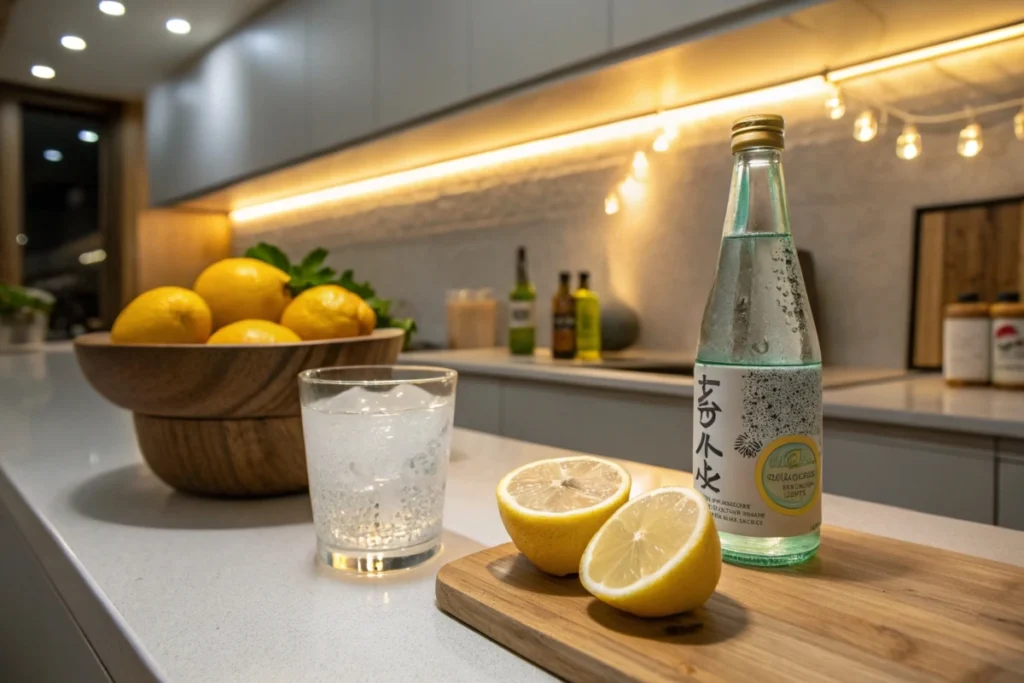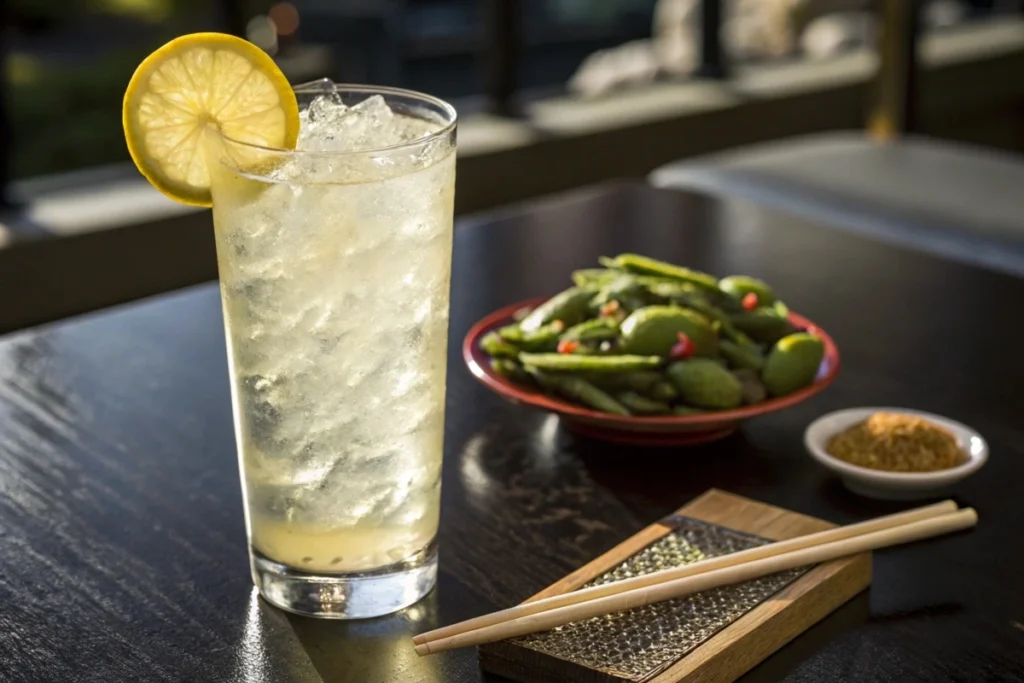Introduction
When it comes to japanese lemon sour recipe trends, this tangy, fizzy cocktail has quickly become a favorite. Within the first 100 words, let’s highlight the primary keyword. Japanese lemon sour recipe variations have spread worldwide, offering a balanced, refreshing drink perfect for dinner gatherings or casual evenings. Inspired by lemon sour japan culture, this cocktail blends shochu or vodka, fresh lemon juice, and sparkling water. It’s easy to prepare, appealing to both cocktail enthusiasts and beginners.
What is Japanese lemon sour made of? Traditionally, it’s a simple mix: spirit (often shochu), lemon, and soda water, slightly sweetened. Many bars now add a twist—like honey or yuzu—for complexity. The popularity of brands like Asahi Lemon Sour reflects Japan’s love of citrus-infused drinks. Enjoying a lemon sour aligns with Japanese culinary values: balance, subtlety, and seasonal produce. Serve it as a refreshing companion to savory dishes or a palate cleanser after a rich meal. For a complete culinary experience, consider pairing it with a japanese-chicken-fried-rice-recipe- to create a well-rounded dinner.
In this article, we’ll explore the drink’s origins, authentic ingredients, and pro tips to perfect your homemade Japanese lemon sour. You’ll learn about its cultural context, discover practical use cases, and find answers to common questions. By the end, you’ll feel confident crafting this zesty cocktail at home.

Main Sections
1. Understanding the Essence of a Japanese Lemon Sour
Japanese lemon sour recipe essentials focus on simplicity and balance. In Japan, lemon sour is called “remon sawa” (レモンサワー), a highball-style drink often found in izakayas and restaurants. It commonly includes shochu, a distilled spirit from rice or barley, but vodka can substitute. The flavor hinges on fresh lemon juice’s brightness and the crispness of sparkling water. A small amount of sugar or syrup can soften the tart edge, creating a refreshing, not-too-sweet cocktail.
What is Asahi Lemon Sour? It’s a branded version that encapsulates the classic taste. Many Japanese beverage companies produce canned lemon sours, making it a popular ready-to-drink option. These commercial versions vary in sweetness and intensity, but the homemade route allows customization. Lemon sour japan style is distinct from Western cocktails; it’s less sugary and more about highlighting citrus.
Pairing lemon sour with dinner is effortless. Its acidity cuts through rich flavors—ideal with grilled fish, yakitori, or savory fried rice. For plant-based eaters, consider combining lemon sour with vegan-japanese-recipes to enjoy a light, crisp contrast. The cocktail cleanses the palate, setting the stage for another bite.
Bartenders often garnish lemon sour with a fresh lemon wheel. Some add sour japan twists like pickled plums or shiso leaves. These subtle additions offer complexity. If you prefer a sweeter note, experiment with honey or a dash of yuzu liqueur. Once you master the core recipe, feel free to adapt it to personal taste.
Consistency matters. Ensure proper dilution by measuring spirits and adjusting soda water. Lemon sour cocktail recipe guidelines generally suggest a ratio: 1 part spirit, 1 part lemon juice, 2-3 parts soda. Adjust to your liking. Ultimately, a Japanese lemon sour aims to be sessionable—refreshing enough for multiple rounds without overwhelming the palate.

2. Key Ingredients and Techniques
For an authentic japanese lemon sour recipe, start with quality ingredients. If using shochu, choose a clean, neutral type. Vodka works if shochu isn’t available, but shochu offers a subtle depth. Fresh lemons are crucial. What does Japanese lemon taste like? Japanese lemons (like yuzu or sudachi) differ from Western varieties in aroma and complexity. But standard lemons suffice for a classic lemon sour. Just ensure they’re fresh and juicy.
To make a basic lemon sour:
- Ingredients:
- 2 oz (60ml) shochu or vodka
- 1-1.5 oz (30-45ml) fresh lemon juice
- 0.5 oz (15ml) simple syrup or a pinch of sugar (adjust to taste)
- 4-6 oz (120-180ml) chilled sparkling water
- Ice and a lemon wheel garnish
- Method:
- Fill a chilled glass with ice.
- Add the spirit, lemon juice, and sweetener. Stir gently to combine.
- Top with sparkling water and give a brief stir. Garnish with a lemon wheel.
Adjust sweetness as desired. For a drier taste, skip the sugar. If you want complexity, add a hint of ginger syrup or a small splash of japanese-bbq-sauce-chicken-recipe-authentic-and-easy inspired sauce (just a drop!) for a savory twist. While unorthodox, it can create depth.
For those curious about lemon sour cocktail recipe variations, consider asian asparagus recipes or japanese-asparagus-recipe dishes to pair with. The bright acidity complements green vegetables beautifully. If you’re looking for a post-dinner treat, pair lemon sour with traditional-japanese-desserts-recipe for a sweet finish.
Technique-wise, maintain balance. Too much lemon juice makes it puckeringly sour; too little results in blandness. Taste as you go. Achieve a gently tart, crisp profile that refreshes rather than fatigues the palate.
When serving guests, prepare components beforehand: squeeze lemon juice in advance, chill your soda, and set up a small garnish station. Presenting a lemon sour with elegance—cold glassware, fresh garnish—elevates the experience.

3. History and Background
Origins in Highball Culture
The japanese lemon sour recipe we enjoy today evolved from Japan’s broader highball culture. Highballs—spirit diluted with soda—have been staples since the mid-20th century. Whiskey highballs soared in popularity first, as Japan embraced an approachable drinking style that balanced alcohol with refreshment. Lemon sour emerged later as a variation focusing on citrus brightness.
Popular Lemon Drinks in Japan
What is a popular lemon drink in Japan? Beyond lemon sour, Japan loves lemon-flavored beverages like Lemon Chu-Hi (shochu highball), canned lemon haposhu (low-malt beer with lemon), and soft drinks infused with lemon. Lemon sour found its niche among adult consumers seeking a lighter alternative to beer or heavy cocktails. Bars and izakayas began serving it as an easy-drinking option that paired well with savory snacks.
Surge in Popularity in the 2010s
In the 2010s, lemon sour’s popularity surged again, boosted by nostalgia and health-conscious trends. Citrus, perceived as “clean” and vitamin-rich, appealed to younger drinkers. Brands like Asahi Lemon Sour capitalized on this, offering canned versions. This convenience made lemon sour a go-to home drink as well. Today, supermarkets stock multiple lemon sour variants, from ultra-dry to fruity-sweet, reflecting diverse palates.
Adaptability and Culinary Integration
The shift from traditional highballs to citrus-infused versions mirrors Japan’s culinary adaptability. As foreign spirits like vodka or Western cocktails influenced bartending, the lemon sour adapted local preferences: less sugar, more freshness. This drink also resonates with the Japanese concept of “refreshing palate cleansers,” often found in meals. Pairing lemon sour with grilled fish or yakitori cuts through fattiness, a role previously played by pickled ginger or radish.
Hybrid Heritage and Modern Influence
Compare this evolution with other Japanese staples. Just as japanese-curry-recipe-one-piece fuses foreign and local flavors, lemon sour embodies a hybrid heritage: the Western highball format, Japanese shochu, and a universally beloved citrus. The result is a uniquely Japanese cocktail enjoyed at home, in bars, and at summer festivals.
Symbol of Socializing and Dining
As Japan’s bar culture modernized, bartenders experimented with garnishes and syrups, refining the lemon sour japan experience. The drink became a symbol of relaxed dining and socializing—perfect for a casual dinner with friends.
4. Practical Examples/Use Cases
Picture a small dinner party at home. You’ve prepared a savory spread: grilled fish, pickled vegetables, and a bowl of steaming rice. Instead of serving wine, surprise guests with a japanese lemon sour recipe cocktail. The tartness refreshes after bites of rich umami, enhancing the meal’s overall enjoyment.
For a casual movie night, pair lemon sour with light snacks like edamame or vegetable tempura. The drink’s crisp profile balances fried textures. If you’re incorporating more plant-based meals, try lemon sour cocktail recipe with vegan-japanese-recipes like tofu teriyaki. The cocktail’s lemony brightness complements umami sauces and fresh herbs.
Hosting a barbecue? Offer lemon sour as an alternative to beer. Its lower sweetness and subtle flavor won’t overpower grilled meats or vegetarian kebabs. Add a small station with lemon wedges, syrups, and maybe a pinch of chili flakes for guests to customize their drink. This interactive element makes your event memorable.
Another scenario: a quiet weekend afternoon. Mix a lemon sour before tackling chores or enjoying a good book. Its light alcohol content keeps it sessionable. Serve it alongside mashed-japanese-sweet-potato-recipe as a sweet-savory afternoon snack.
For a romantic dinner, consider pairing lemon sour with steak-japanese-recipe slices or japanese-old-fashioned-recipe inspired cocktails as a variety option. While the old-fashioned provides warmth, the lemon sour refreshes the palate.
These examples highlight the lemon sour’s adaptability. Whether fancy or casual, meat-based or vegan, this cocktail integrates seamlessly. It complements rather than competes with flavors, making it a versatile option for various cuisines and occasions.

5. FAQs about japanese lemon sour recipe
1. What is Japanese lemon sour made of?
A basic japanese lemon sour recipe includes shochu or vodka, fresh lemon juice, and soda water. Some add a bit of sugar or syrup for balance. The result is a light, tart, and refreshing drink perfect for dinner or casual sipping.
2. What is Asahi Lemon Sour?
Asahi Lemon Sour is a branded canned beverage offered by Asahi. It captures the classic lemon sour taste: crisp, citrusy, and not too sweet. It’s a convenient option for those who want an authentic lemon sour without mixing ingredients themselves.
3. What is a popular lemon drink in Japan?
Aside from lemon sour, Japan enjoys lemon chu-hi (shochu-based highballs), lemon-flavored soft drinks, and various citrus-infused alcoholic beverages. Lemon sour stands out as a popular bar and izakaya choice, served ice-cold to complement savory dishes.
4. What does Japanese lemon taste like?
Japanese lemons (or related citrus like yuzu, sudachi) can be more fragrant and slightly different in aroma than standard lemons. However, using regular lemons works fine. You’ll get a bright, tangy flavor that pairs well with umami ingredients.
5. Can I make a lemon sour without shochu?
Absolutely. Vodka is a common substitute. The key is a neutral spirit that doesn’t overshadow the lemon. Experiment with gin or rum for unique twists, but keep in mind that these alter the drink’s flavor profile.
6. How sweet should a lemon sour be?
Sweetness is subjective. Many prefer a dryer taste, adding minimal sugar. Start with a teaspoon of simple syrup and adjust. The goal is a gentle balance that highlights lemon’s tartness.
7. Should I refrigerate ingredients?
Yes. Chill your soda water, spirit, and lemons for a crisp finish. Cold ingredients maintain carbonation and brightness. Serve the drink immediately after mixing.

Conclusion for japanese lemon sour recipe
Japanese lemon sour recipe methods offer a simple, refreshing cocktail that elevates any dinner experience. The combination of citrus brightness, subtle sweetness, and effervescence brings balance to savory, rich dishes. By choosing quality ingredients, adjusting sweetness levels, and playing with garnishes, you’ll craft a drink that reflects Japanese culinary principles: harmony, seasonality, and minimal fuss.
Now that you know how to make a lemon sour, integrate it into your next meal. Serve it as an aperitif, pair it with a savory main, or enjoy it alongside japanese-dessert-recipes for a balanced finish. If you’re curious about other Japanese cocktails or dishes, discover japanese recipes to broaden your culinary repertoire.
As you perfect your lemon sour technique, remember that experimentation is welcome. Try different spirits, tweak the lemon-to-soda ratio, and explore new flavor accents. Whether hosting friends or treating yourself, the Japanese lemon sour is a versatile, refreshing option that brings a taste of Japan’s drinking culture to your table.

for Honey Lemon Tea
